
The heroine of women painters, who championed the use of folk symbols to illustrate and elucidate self, surrealist painter, and merger of social realism and confrontational renaissance portraiture, is highly relevant to the present art scene. In painted self-portraits she surrounds her image with symbols of Mexican folklore and culture as in My Grandparents, My Parents and Me (1936),to exorcize her self and announce her heritage. She painted to self-treat the emotional and physical pain she endured throughout her life. Her body, once encased in plaster, held together with steel, replacing a natural with an artificial leg crossing the boundary between cyborg and woman, explored technology’s impact on the human.
Kahlo painted her artificial leg and chest cast, adding creativity and fashion to medical necessities, bringing art to science and technology. She created a fashionable appendage and showed ways technology affects our lives and bodies, bringing humanism to our mechanistic society.
She studied Jewish authors and themes, focusing on studies of persecution including Alfonso Toros’, met Chagall in Mexico in 1942, undoubtedly finding his surrealist folk images akin to hers, and studied and portrayed Mexican folk symbols intensely. She reconciled her Communism with an intense focus on the self and her mother’s Catholicism and Diego Rivera’s atheism by using the symbols and culture of Mexico in her art. She devised her own language, using symbol, sign and mark to found a feminist, Mexican language.
Guillermo Kahlo, a German Lutheran, whose first marriage produced two daughters, both sent to convent school, married Matilde Calderon y Gonzalez, daughter of a Spanish general and Michoacan. They became the parents of Magdalena Carmen Freida Kahlo on July 6, 1907. She joined two older sisters, with one to come after her. Her father, a professional photographer so excelled professionally that the Mexican government chose him to document colonial architecture in Mexico. His favorite child, Frieda accompanied him on his travels.
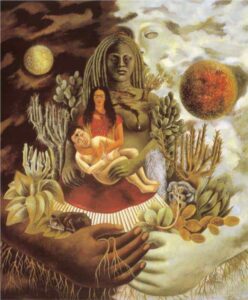
(c) The Jacques and Natasha Gelman Collection of 20th Century Mexican Art and The Vergel Collection
At the age of six, Frieda was hospitalized, allegedly with polio though no medical records document that illness, and it might also have been white tumor, with resultant damage to her right leg. Home from the hospital, she was enrolled in a German elementary school, Colegio Aleman, where she was sexually abused, later earning a place at the National Preparatory School. There she excelled at her studies in botany, medicine and social sciences and began a relationship with Alexandro Gomez Arias, a member of the Cachuchas Student Group, devoted to Socialist-Nationalist ideas and literature
Acknowledging her Mexican heritage, thereby rejecting her father’s German heredity in favor of Alexandro’s identity and politics, Kahlo changed her name’s spelling to the Mexican Frida, her birthdate to 1910, the year of Mexico’s post-Revolution, and the day to 7 to reflect the deer in Aztec codex Vaticanus, whose number 7 also symbolizes the right foot. Oddly, she consequently made her birthdate 7/7, the date of the tube/bus bombing in London, that injured and killed so many.
In 1925, the wooden bus Frida and Alexandro rode home from school was struck by an electric tram. Several people were killed and Frida suffered extensive life-threatening injuries. Her pelvis splintered, her spinal column shattered, her leg broke in twenty-two places and a steel handrail pierced her pelvis exiting through her vagina. The accident proved devastating to her body, resulting in several operations, and an inability to carry a child. Her body image, a stunted right leg, damage from the accident and physical pain led to loss of body confidence destroying her ego, causing her to question her identity and form her own new self-image. Recuperating in the hospital, her mother gave her an easel and paints to occupy her. Her physical damage, long hospital stay and shunning by her peers fed her art in coming years. Her artwork; broken bodies held with arterial threads; spines exposed to resemble Greek columns, bodies in hospital beds mirror her suffering and remaking of body and identity.
In 1928, Diego Rivera painted the Creation mural in the ampitheatre of the National Preparatory School. Frida, admiring his work, wanted to meet him. A fellow member of the Young Communist League, Tina Mendotti, Antonio Mella’s lover introduced Kahlo to Rivera. Rivera was impressed by her artwork and encouraged her, maybe also because, although married, he liked the Frida he saw. In 1929, Rivera, at forty-three years old married twenty-two year old Frida Kahlo, his third wife. Already seriously exploring Mexican iconography and folktales, access to Rivera’s collection of pre-Hispanic sculpture and artifacts and identifying with him led Frida to embrace and paint her Mexican identity.
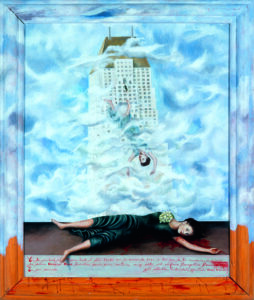
As the Nazis advanced in Europe, her mother and Frida were threatened. This threat turned her work from self to family, reflected in My Grandparents and Me (1936). Although it has been written that her father was a non-practicing Jew, of Hungarian Jewish roots, his family was Lutheran and German for several generations. She was friends with eminent Jews including Chagall and Trotsky.
However, the mechanized army overtaking the world cannot have escaped the notice of a young woman whose body had been ruined by a steel wedge going through it from an electric tram. The steel war machines overtaking the world must have reminded her of the steel she now carried in her body and the steel that had damaged her. That same steel of the conquistadores damaged her Mexican/Aztec civilization making the Mexicanness of her mother a reaction to this terrorism and an alluring alternative.
Kahlo’s life and work is important in the annals of feminist art history, teaching all women that we can make our own identity, that bodily image need not conform to prescribed norms, and that visual art need not reflect the idealized woman often portrayed by western male artists. Her appropriation of Aztec and Mexican Indian symbols formed her identity and produced a guide for those of various ethnic groups to be proud of their heritage and to pursue their own identification. From hereon she would use Aztec and Mexican Indian symbols to augment her self and family portraiture, and to illustrate her philosophical and sociological ideals.
Identifying with the painted, mutilated figurines in Rivera’s collection, with their legs or heads chopped off, she painted The Four Inhabitants of Mexico City (1938), California private collection) and the now lost The Wounded Table. (1940) In The Four Inhabitants of Mexico City, Judas, a straw horseman on a straw horse, a skeleton, a clay figure, visibly pregnant and young Frida, sit on the ground. Clearly, the straw horseman only passes by, threatened by fire engulfing a building on the upper right of the market square. These are all threatened figures, watched by Frida, in a Mexican zocalo, usually a scene of music and enjoyment. She fuses European figures with pre-Hispanic symbols to paint a work where the visibly pre-Hispanic straw horseman, threatened, stops before he is engulfed by fire. The metaphor is clear; the two sides of Frida Kahlo’s cultural synthesis evident. The skeleton presents the alternative to life, the pregnant clay figure’s glued-on head, clearly askance, draws a parallel to Kahlo’s aborted first pregnancy, which her broken body could not support. She, like the horseman chose life over possible death. The Judas figure is also one of exoneration. Surrounded by cords to detonate fireworks, this Mexican Judas chases away evil and bad memories ridding Mexico of corrupt government figures. In the Wounded Table, layers of paint incorporate Mexican and Catholic signs, serving to bury (thus the skeleton) Kahlo’s bad memories and exonerate her for the sins that she might have believed caused her physical injuries and subsequent need to abort.
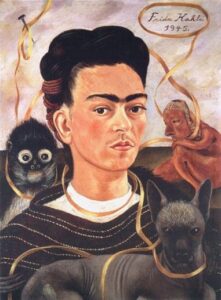
She greatly wanted to bear Rivera’s child, but regretted that she could not, in her physical state, having suffered miscarriage. Diego and Kahlo read Luther Burbank’s work on selective breeding, considering whether she should bear a child with her history (father’s epilepsy), with Kahlo later painting, Portrait of Luther Burbank in 1931. Holding a philodendron variety, monstera, he looks like a Germanic monster, legs covered by a tree trunk ending in roots standing on a skeleton, recalling Day of the Dead icononography.
Self-Portrait on the Border Line Between Mexico and the United States, 1932, carries the symbols of Mexico fallen in the sand; pyramids, clay figurines and poisonous plants including the pasque flower used to induce abortion. Factories and machines of the US with flag overhead rise behind her. Though devoid of people, the US side provides hope, activity and modernization absent from the sand and ancient artifacts of Mexico. Technology energizes the US side, but natural sources remain in Mexico. This is the divide of her life, medicine and its cures and advances versus the magic of Mexican culture; steel versus skin and human organs; humanity versus technology; Communism versus US style democracy. She traversed the border between old and new, north and south, ancient and modern. In the US from 1929-32, she exhibited with Julian Levy’s gallery, as a surrealist with others who claimed this genre. Although she denied the label, her coded references to creation, and its faults link her to surrealism.
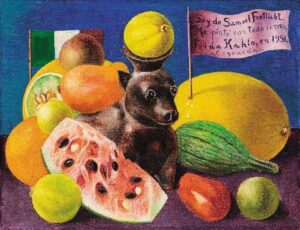
Titolo: Natura morta (Sole di Samuel Fastlicht)
Anno: 1951
Memory or The Heart, (1937) shows Kahlo’s European school clothes, Tehuana dress and the rail (from her accident) piercing her heart, fallen to the ground. She stands between masculine earth and feminine flowing water, negotiating gender. Two Nudes in a Forest or My Nurse and I or the Earth Itself (1939) begs us to decide who the two women portrayed are. Does this depict a lesbian affair or some other relationship? Providing alternate names, she may have alluded to her confused sexual identity and fear of announcing or acknowledging it. Frida Kahlo announced in her diary in 1932, the year of her miscarriage and her mother’s death that she gave birth to herself, knowing she will only mother herself, illustrating it in My Birth (1932). As she created herself, women worldwide are seeking to do the same today. The issues we face today are those addressed by Kahlo.
In April 1938, Andre Breton joined Trotsky, Rivera and Kahlo lecturing at the Universidad de Mexico City. Insisting on art independent of governmental authority in his Manifesto for an Independent Revolutionary Art, signed by Rivera and Kahlo, Breton rejected Trotsky’s view that DeSade instigated the liberation movement. By 1941, Trotsky had been assassinated, Frida had returned from the US and remarried Rivera (1935), pursuing a platonic relationship with him. Her spine was successfully fused, supported by a metal rod, but exorbitant pain caused her drinking and depression.
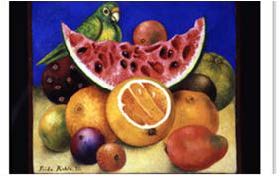
© Banco de México Diego Rivera Frida Kahlo Museums Trust
In The Wounded Table, (1940), perhaps her most biographical painting, the table with four human legs contains all the signs and symbols of a Last Supper for Frida: the table, bleeding from cracks in the wood surface, the deer, looking away, the skeleton again, Judas, this time dressed in Rivera’s clothes, to mark his recent infidelity, the pre-Hispanic clay figure attached to a cuff on Frida’s arm, as if feeding her blood and her sister Christina’s and Diego’s children, Antonio and Isolda. Frida presides over all in Jesus’ place. Her extensive use of the monkey symbol, and adoption of a monkey into her house, might refer to the medieval convention of the monkey warning of the danger inherent in too much love, wherein the father monkey squeezes its offspring to death when carrying it. This so-called monkey love could well be the impetus for guilt in her later paintings, but is also a symbol of sexuality and licentiousness. Whether real or imagined, the monkey and the red strings, which like blood vessels bind her to the monkey, refer to those who love too strongly.
Wings and airplanes serve are recurring motifs in Kahlo’s paintings, perhaps reminiscent of the Lilith myth: Adam and Lilith were God’s first human creations, but when Adam wanted Lilith sexually, she refused and called on God to help her. God gave her wings to fly away and created Eve in her stead. In her earliest Self Portrait: Time Flies, (1929) an airplane overhead suggests the young girl’s ability to fly away. In Lucha Maria (Fight Maria, 1942), the little girl is encouraged to fight rather than accept her situation. The face in the background cloud resembles her father, as two sun medallions, used in a ring Kahlo wore, Aztec symbols for the male/female union, juxtapose her two worlds. In They Asked for Planes But Were Given Straw Wings, (1938) a young girl in Tehuana clothes foregrounds an airplane, clearly illustrating her desire to fly away, but only straw wings appear. Red ties, like umbilical cords, hold her to the land of Mexico, symbolized by two pyramids in the background.

Titolo: Diego nella mia mente
Anno: 1943
As Mexico’s economic health improved, Kahlo’s began failing. In Self Portrait with Bonito, (1941) painted after her return to Mexico following the death of her father, the monkey is absent, replaced with a parrot on her shoulder. The parrot, native to Latin America and colorful, is included in this painting with caterpillars and butterflies, acknowledging her maturation. Her favorite ring, worn on her finger in Me and My Parrots (1941) displays the lingam, denoting male power within the yoni, the female circle. She is finally free to love Rivera, although their remarriage stipulates platonic love, resulting in The Self-Portrait as a Tehuana (1943) and the double portrait, Diego in my Thoughts, Diego and Frida (1944).
In incredible pain, thinking about the end of her life, The Mask (1945) shows Kahlo with the red Malinch mask, of Mexican lore attributed to Malinche, Cortes’ mistress who had sex with Cortes and so brought death to the Aztecs. As we observe tears in Frida’s eyes behind the mask, we know that the sexual, promiscuous image is a mask. During the platonic stage of love she now endures with Rivera, painting The Wounded Deer (1946), the animal Frida associates with lives in a green, pastoral forest, at peace with nature. The poem accompanying the painting indicates her desire to reincarnate as a deer.
By 1946-7, Kahlo was exploring the Buddhist concept, Karma. New bodies emerge from piles of bodies and heads, but she acknowledges her abandonment of Buddhism with Ruin (1947), with cracks in Buddha’s head and the gravestone inscribed Ruin/Bird/House/Love Nest All in Vain! At this time, Rivera abandoned atheism after criticism of his mural at Mexico City’s Hotel Del Prado following objections to his depiction of Mexico’s history and the painted note, “Dios No Existe”, (God Does Not Exist) held by a liberal Mexican reformer. Frida’s catalogue essay for the mural calls Rivera strong and amazing.
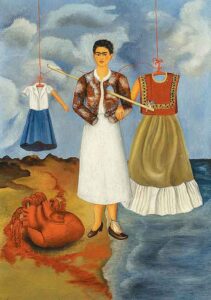
Private collection.
Shortly after, Kahlo endured a year in a hospital, painting again in 1951 a portrait of her father from a photograph as a young photographer and Self Portrait with the portrait of Dr. Farill, the doctor looking away from her. In March of 1953, her friend and fellow artist, Chabela committed suicide. Frida, on Demerol and alcohol badly missed her, and again embraced Marxism, denouncing Trotsky and condemning her paintings as not sufficiently socially relevant. She turned from individualistic portrayals of those dear to and condemned by her to consideration of the greater, impersonal society, with her final paintings portraying Marx, Engels, Lenin and Stalin. Her last unfinished painting features pink genitalia on a plate surrounded by Marxist-Leninist heroes. Neither politics, nor philosophy nor sensuality would save her or society. She gave up, with no desire for incarnation in any form, with her last written words, “I hope never to return”, not in any form, not as prescribed by Buddhism or Mexican folklore, but finally, ascending, without even wings to nothingness.
Her life and work, of course, lives on. That is the wonderful thing about art: her symbols, her history, her wishes and thoughts, fears and philosophies, family and friends live on though her physical, damaged body is no more. She truly is a mother of feminist art, deriving her cultural identity, expressed in her paintings and surroundings from her mother and her mother’s heritage, and making it clear that she, through art, could form her own self.
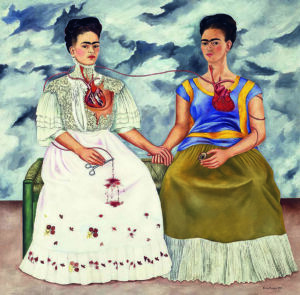
Museo de Arte Moderno Conaculta INBA Mexico
The present exhibition, opened June 16 at the Victoria and Albert Museum, in London, Making Her Self Up, corroborates her compilation of her cultural and personal identity. Showing the painted prosthetic leg and boot, the painted chest cast, her dresses, skirts and blouses, makeup, self-portraits and photographs of Kahlo and friends and family, this exhibition of artifacts from her residence in Mexico City, the Blue House, shows how Frida Kahlo made her self up.
Nancy Nesvet
Volume 32 no 6 July/August 2018 pp 6-11
